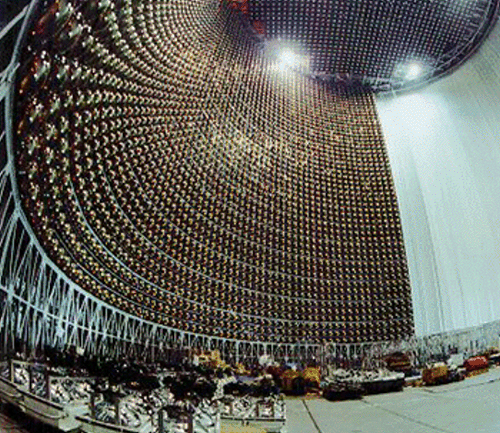|
|
|
|
..
Accident grounds neutrino lab
Neutrino physics has suffered a serious blow following an accident at one of the field’s leading facilities. The Super-Kamiokande detector in Japan - which in 1998 announced evidence for the existence of neutrino mass - will be out of action for at least a year after most of its 11 000 photomultiplier tubes imploded. Officials at Super-Kamiokande have not confirmed the cause of the accident but it is thought that the pressure of the water inside the detector was too high. Wonderwall The Super-Kamiokande experiment - located a kilometre underground in central Japan -consists of a tank filled with 50 000 tons of water surrounded by photomultiplier tubes. These tubes detect the faint flashes of light known as Cerenkov radiation given off by electron- and muon-neutrinos when they interact with electrons in the water molecules. One of these tubes - each of which contains a vacuum - is thought to have imploded as the detector was being refilled with water following maintenance work. It is believed that the energy released from this implosion caused a shock wave in the water, leading to a chain reaction of implosions in the remaining tubes. According to the New York Times, about 7000 of the tubes imploded, which puts the cost of the accident at about $20 - $30m since each tube costs about $3000. The director of the Kamioka Observatory, the organization that owns Super-Kamiokande, is putting on a brave face. “We will rebuild the detector,” says Yoji Totsuka. “There is no question”. Totsuka proposes to restore the number of photomultiplier tubes to about half of the original number in order to resume the K2K experiment as soon as possible, perhaps within a year. This experiment – in which a beam of muon neutrinos travels from the KEK particle physics lab on the east coast of Japan to Super-Kamiokande – needs to run for about another two years in order to confirm its initial results on neutrino mass. Once this experiment is complete, Totsuka says that Super-Kamiokande will be upgraded in time to receive neutrinos from the Japanese Hadron Facility (JHF), which is due to be commissioned in 2007. The JHF will provide a beam of neutrinos much more intense than that from K2K, allowing more precise measurements of neutrino oscillations and other properties of neutrinos. The upgraded facility should also be able to detect the thousands of neutrinos produced by rare supernovae explosions in the Milky Way. “It would be a great loss to the field not to get these
results,” says Dave Wark, a particle physicist at the Rutherford Appleton
laboratory in the UK. “In light of that I hope that Super-Kamiokande gets
the support it needs to recover completely from this disaster. One should
always remember that building state-of-the-art experiments like Super-Kamiokande
always involves pushing the edge of what is technologically possible, so
setbacks are inevitable”.
Edwin Cartlidge is News Editor of Physics World SOURCE: Physics World |
|
| FAIR USE NOTICE: This page contains copyrighted material the use of which has not been specifically authorized by the copyright owner. Pegasus Research Consortium distributes this material without profit to those who have expressed a prior interest in receiving the included information for research and educational purposes. We believe this constitutes a fair use of any such copyrighted material as provided for in 17 U.S.C § 107. If you wish to use copyrighted material from this site for purposes of your own that go beyond fair use, you must obtain permission from the copyright owner. | |
|
|

